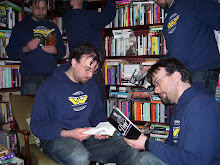* * *
CAUSTIC COVER CRITIC: What's your design background? How did you get into book design?
RICHARD GREEN: I graduated from the London College of Printing in 1995 after 3 years studying graphic design. My first design job was for a charity back home in North Wales. I did that for a year before I got my first publishing job with HarperCollins Publishers in London. At that time the art department was responsible for designing covers for all the divisions: Fiction, Children’s, Collins Reference, and the Non-Fiction lists. So it was a great education for me having to be so flexible in my approach to design.
CCC: How did you come to work on the Victorian Bestsellers--are you a fan of Gothic and Sensation fiction?
RICHARD GREEN: I’d never read any of these books before I worked on them. My starting point was a new cover I had just designed for Phantom of the Opera which is a similar genre and the same format, so when this project came up it was a good opportunity to evolve the work I’d been doing on that. The end result turned out to be further removed than I had anticipated, but I was pleased to have come up with a new look for this series.
CCC: Do you work mainly with computer or old-fashioned materials? These covers have a nice,
painted feel, however they were produced.
RICHARD GREEN: Most of my work starts on a layout pad I always have in front of me on my desk. I’ll usually sketch some initial ideas down then scan them into the computer. From there I find it much easier to try different colours/layouts, etc. On this occasion I had just bought a Japanese brush pen so was trying it out to see what effects I could get with it. I liked the looseness of the sketches I’d drawn so fitted them around some old Victorian woodblock type I found.
CCC: What are the challenges of designing a set of books, rather than an individual title?
RICHARD GREEN: The main challenge I found was retaining a sense of the series style whilst making each cover different from the last. There are 10 books in this series so it got pretty tough towards the end.
CCC: What is some recent work of which you're most proud? What about older work?
RICHARD GREEN: I’ve worked across a pretty broad spectrum of titles over the years that require different ways of working, but I probably enjoy the illustrative side of things the most, so they tend to be the ones I am happiest with. It’s not necessarily the most sophisticated designs that I’m most proud of; I think answering the design brief well is quite satisfying. Pop Goes the Weasel is a good example of that, it seemed to hit the spot and sold pretty well.
CCC: If you could design, inside and out, without budget limitations, any book from the history of literature, what would it be?
RICHARD GREEN: That’s a tricky one. I’ve never designed the interior of a book, so that would be a challenge in it’s self. But I guess something I could illustrate as well as design.
CCC: Is there any neglected book you'd love to draw to people's attention as something they should seek out?
RICHARD GREEN: I’m not a big reader of books, I’m more interested in their design so I often search out beautiful old books at markets or second-hand shops. I’m always looking for something new for inspiration, and to broaden my design knowledge. So keep your eyes peeled!
CCC: Thank you, Mr Green!
* * *
By the way, I can't let this opportunity to quote from The Woman in White go past. It's a wonderful book (so of course Andrew bloody Lloyd-Webber had to go and make a musical of it), with some gorgeous writing and one of the best, most charming villains of Nineteenth-Century fiction (Count Fosco!). Here's the sequence where the book's hero first encounters the book's heroine (who was partly based on Mary Ann Evan, aka George Elliot).
I looked from the table to the window farthest from me, and saw a lady standing at it, with her back turned towards me. The instant my eyes rested on her, I was struck by the rare beauty of her form, and by the unaffected grace of her attitude. Her figure was tall, yet not too tall; comely and well-developed, yet not fat; her head set on her shoulders with an easy, pliant firmness; her waist, perfection in the eyes of a man, for it occupied its natural place, it filled out its natural circle, it was visibly and delightfully undeformed by stays. She had not heard my entrance into the room; and I allowed myself the luxury of admiring her for a few moments, before I moved one of the chairs near me, as the least embarrassing means of attracting her attention. She turned towards me immediately. The easy elegance of every movement of her limbs and body as soon as she began to advance from the far end of the room, set me in a flutter of expectation to see her face clearly. She left the window—and I said to myself, The lady is dark. She moved forward a few steps—and I said to myself, The lady is young. She approached nearer—and I said to myself (with a sense of surprise which words fail me to express), The lady is ugly!


























2 comments:
What an interesting interview - thank you for sharing. i think that the designs are excellent and manage to be both gothic and welcoming. Enjoying your blog, Hannah
Thanks, Hannah. I have to admit to 'trading up' a couple of books I already owned to get these new designs.
Post a Comment